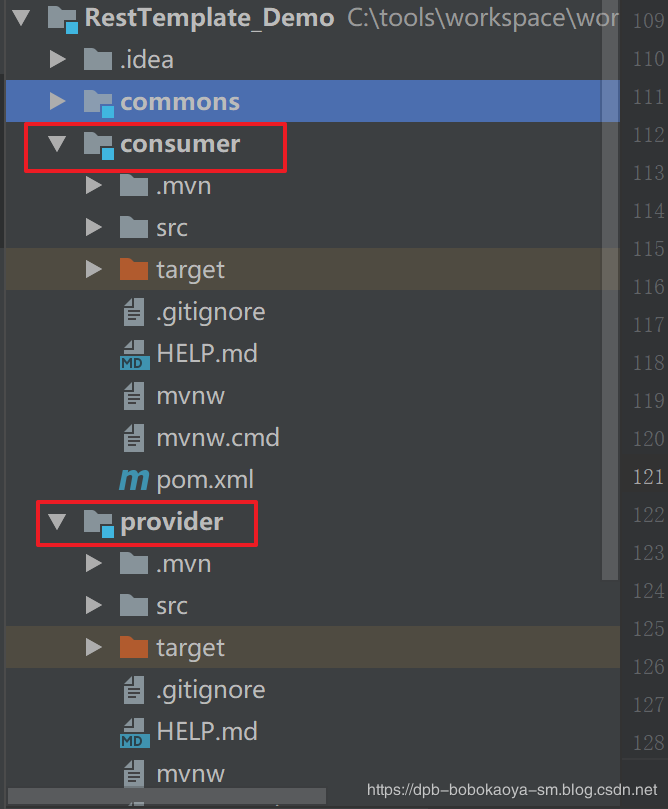如何正确的使用Spring RestTemplate?针对这个问题,这篇文章详细介绍了相对应的分析和解答,希望可以帮助更多想解决这个问题的小伙伴找到更简单易行的方法。
1.环境搭建
为了演示RestTemplate的使用,我们创建两个SpringBoot项目,一个provider作为server端,一个consumer作为服务调用方法

2.API方法介绍
| API | 说明 |
|---|---|
| getForEntity() | 发送一个HTTP GET请求,返回的ResponseEntity包含了响应体所映射成的对象 |
| getForObject() | 发送一个HTTP GET请求,返回的请求体将映射为一个对象 |
| postForEntity() | POST 数据到一个URL,返回包含一个对象的ResponseEntity,这个对象是从响应体中映射得到的 |
| postForObject() | POST 数据到一个URL,返回根据响应体匹配形成的对象 |
| headForHeaders() | 发送HTTP HEAD请求,返回包含特定资源URL的HTTP头 |
| optionsForAllow() | 发送HTTP OPTIONS请求,返回对特定URL的Allow头信息 |
| postForLocation() | POST 数据到一个URL,返回新创建资源的URL |
| put() | PUT 资源到特定的URL |
| delete() | 在特定的URL上对资源执行HTTP DELETE操作 |
| exchange() | 在URL上执行特定的HTTP方法,返回包含对象的ResponseEntity,这个对象是从响应体中映射得到的 |
| execute() | 在URL上执行特定的HTTP方法,返回一个从响应体映射得到的对象 |
3.具体使用
我们通过常用的http协议的四种请求方式来看下效果
3.1 无参请求
我们先来看下服务端请求方法不需要接收参数,
getForEntity
通过getForEntity来实现
服务端
/**
* 无参,返回字符串
* @return
*/
@GetMapping("/server1")
public String server1String(){
System.out.println("服务端被访问了...");
return "success";
}调用
/**
* RestTemplate 访问 provider的第一个服务 server1
*/
@Test
public void contextLoads() {
String url = "http://localhost:8080/server1";
RestTemplate restTemplate = new RestTemplate();
ResponseEntity<String> entity = restTemplate.getForEntity(url, String.class);
// 获取响应的状态
HttpStatus statusCode = entity.getStatusCode();
// 获取响应的header信息
HttpHeaders headers = entity.getHeaders();
// 获取响应的body信息
String msg = entity.getBody();
System.out.println(statusCode);
System.out.println(headers);
System.out.println(msg);
}输出结果

说明:
1.getForEntity()方法执行返回的类型是ResponseEntity<T>,ResponseEntity<T>是Spring对HTTP请求响应的封装,包括了几个重要的元素,如响应码、contentType、contentLength、响应消息体等,在输出结果中我们能够看到
2.getForEntity()的参数中第一个是请求地址,第二个是T对应的类型
getForObject
getForObject函数实际上是对getForEntity函数的进一步封装,如果你只关注返回的消息体的内容,对其他信息都不关注,此时可以使用getForObject
/**
* getForObject 访问
*/
@Test
public void contextLoadsObject() {
String url = "http://localhost:8080/server1";
RestTemplate restTemplate = new RestTemplate();
// 直接返回的就是我们需要的结果,但是获取不到对应的响应状态等信息
String msg = restTemplate.getForObject(url,String.class);
System.out.println(msg);
}3.2 有参请求
服务端方法需要接收调用者传递的参数
/**
* 有参,基本数据类型 返回字符串
* @return
*/
@RequestMapping("/server2")
public String server2String(Integer id,String userName){
System.out.println("服务端被访问了..."+id+" "+userName);
return "success--参数得到了";
}
/**
* 有参,基本数据类型 返回字符串
* @return
*/
@RequestMapping("/server3")
public String server3String(User user){
System.out.println("服务端被访问了..."+user);
return "success--参数得到了";
}getForEntity
调用者可以通过两种方式调用
第一种方式通过数字占位符,最后是一个可变长度的参数,来一一替换前面的占位符
/**
* 请求服务并且传递参数
* 基本数据类型
*/
@Test
public void testServer2(){
// 参数在链接地址后
String url = "http://localhost:8080/server2?id={1}&userName={2}";
RestTemplate restTemplate = new RestTemplate();
ResponseEntity<String> entity = restTemplate.getForEntity(url, String.class,5,"bobo");
System.out.println(entity.getBody());
}第二种就是使用name={name}这种形式,最后一个参数是一个map,map的key即为前边占位符的名字,map的value为参数值
/**
* 请求服务并且传递参数
* 基本数据类型
*/
@Test
public void testServer3(){
String url = "http://localhost:8080/server2?id={id}&userName={userName}";
Map<String,Object> map = new HashMap<>();
map.put("id",6);
map.put("userName","波波烤鸭");
RestTemplate restTemplate = new RestTemplate();
ResponseEntity<String> entity = restTemplate.getForEntity(url, String.class,map);
System.out.println(entity.getBody());
}postForEntity
如果是post方式提交请求传递参数我们可以这样使用,如下
服务端:注意要加@RequestBody注解
/**
* 有参,基本数据类型 返回字符串
* @return
*/
@RequestMapping("/server3")
public String server3String(@RequestBody User user){
System.out.println("服务端被访问了..."+user);
return "success--参数得到了";
}客户端
/**
* postForEntity(url,user,String.class)
* url:请求地址
* user:请求提交的数据
* String.class 接收返回数据的类型
*/
@Test
public void contextLoadsObject1() {
String url = "http://localhost:8080/server3";
RestTemplate restTemplate = new RestTemplate();
User user = new User(1,"bobo","中国");
// 直接返回的就是我们需要的结果,但是获取不到对应的响应状态等信息
String msg = restTemplate.postForEntity(url,user,String.class).getBody();
System.out.println(msg);
}3.3 返回自己类型
服务端返回的我们自定义类型的数据
/**
* 返回自定义对象
* @return
*/
@RequestMapping("/server4")
public User server4Object(){
System.out.println("服务端被访问了...");
return new User(2,"李四","深圳");
}客户端:
/**
* 返回类型为自定义类型
*/
@Test
public void testServer5(){
String url = "http://localhost:8080/server4";
RestTemplate restTemplate = new RestTemplate();
ResponseEntity<User> entity = restTemplate.getForEntity(url, User.class);
System.out.println(entity.getBody());
}使用getForEntity和getForObject及postForEntity和postForObject都差不多,注意接收的类型即可。
3.4 返回的list带泛型的场景
此处我们需要使用到exchange方法,特定如下
允许调用者指定HTTP请求的方法(GET,POST,PUT等)
可以在请求中增加body以及头信息,其内容通过参‘HttpEntity<?>requestEntity'描述
exchange支持‘含参数的类型'(即泛型类)作为返回类型,该特性通过‘ParameterizedTypeReferenceresponseType'描述
客户端调用
/**
* 返回 集合带泛型
* @return
*/
@RequestMapping("/server5")
public List<User> server5List(){
System.out.println("服务端被访问了...");
return Arrays.asList(new User(2,"李四1","深圳")
,new User(3,"李四2","深圳")
,new User(4,"李四3","深圳"));
}
关于如何正确的使用Spring RestTemplate问题的解答就分享到这里了,希望以上内容可以对大家有一定的帮助,如果你还有很多疑惑没有解开,可以关注亿速云行业资讯频道了解更多相关知识。
免责声明:本站发布的内容(图片、视频和文字)以原创、转载和分享为主,文章观点不代表本网站立场,如果涉及侵权请联系站长邮箱:is@yisu.com进行举报,并提供相关证据,一经查实,将立刻删除涉嫌侵权内容。